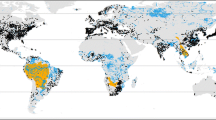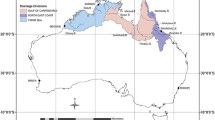Abstract
Plant species are known to be distributed on river banks in a sequence of community zones from the water’s edge to the outer riparian area. The interplay between flow and landscape is thought to drive the existence of these zones, and specifically, between a lower zone that is inundated most years and an upper zone that is inundated less frequently. There remains no consensus on the number of zones present, what their links to flow might be or whether the same zones occur in different basins. This paper reports on the number and nature of vegetation zones along South African rivers in different geographical areas and their relationship to the flow regime. River bank sites in four climatic areas of South Africa were found to support four vegetation zones (in two groups) despite major differences in vegetation community types, climate and patterns of river flow. The Wet bank and Dry Bank zones were separated at an elevation that correlated well with the 1:2 year flood line. If vegetation zones along rivers can be linked in this generic way to the flow regime of a river, it will strengthen our ability to predict vegetation changes likely to occur with flow modifications.






Similar content being viewed by others
Notes
Manning resistance (n) is a composite factor that accounts for the effects of many forms of flow resistance. In general, n increases as turbulence and flow retardation effects increase (Gordon et al. 1992).
Where: (y) is stage, (Q) is discharge and (a), (b) and (c) are constants. (c) Denotes the depth of discharge cessation and thus is often zero in riffles where zero discharge occurs at zero depth, but non-zero in pools.
References
Arcement GJ. Jnr, Schneider VR (1989) Guide for selecting Manning's roughness coefficients for natural channels and flood plains, United States Geological Survey Water-Supply Paper 2339, Denver
Barnes HH (1967) Roughness characteristics of natural channels, United States Geological Survey Water-Supply Paper 1849, Denver
Birkhead AL, Desai AY (2009) Collation and synthesis of hydraulic information from environmental flow requirement studies. WRC KV 291/11. Water Research Commission, Pretoria, South Africa. 18pp
Birkhead AL, James CS (1998) Synthesis of rating curves from local stage and remote discharge monitoring using nonlinear muskingum routing. Journal of Hydrology 205(1998):52–65
Botha M (2001) Dynamics of two South African flood plain forests. Water Research Commission, Pretoria, South Africa. WRC report No. KV 131/01. Water Research Commission, Pretoria, South Africa. 133 pp
Boucher C (2002) Flows as determinants of Riparian Vegetation zonation patterns in selected Southern African Rivers. Enviro Flows 2002 4th Ecohydraulics Conference, Cape Town, South Africa
Brown CA, King JM (2006) Implications of upstream water uses on downstream ecosystems and livelihoods. International Journal of Ecology and Environmental Sciences 32(1):99–108
Clarke KR, Gorley RN (2006) Primer V6: user manual/tutorial. Primer-E, Plymouth
Clarke KR, Warwick RM (2006) Change in marine communities: an approach to statistical analysis and interpretation, 2nd edn. Primer-E, Plymouth
Coates Palgrave KC, Coates Palgrave MC (2002) Trees of southern Africa, 3rd edn. Struik publishers, Cape Town
Department of Water Affairs (2012) Hydrological services – surface water (data, dams, floods and flows). http://www.dwaf.gov.za/Hydrology/, accessed 2011 2012
Dollar EJS, Rowntree KM (2003) Geomorphological research for the conservation and management of southern African rivers. Volume 2: managing flow variability: the Geomorphological response. WRC Report no. 849/2/02. Water Research Commission, Pretoria, South Africa. 283pp
Foxcroft LC, Parsons M, McLoughlin CA, Richardson DM (2008) Patterns of alien plant distribution in a river landscape following an extreme flood. South African Journal of Botany 74:463–475
Francis RA (2006) Allogenic and autogenic influences upon riparian vegetation dynamics. Area 38(4):453–464
Gibbs Russell GE, Watson L, Koekemoer M, Smook LM, Barker NP, Anderson HM, Dallwitz MJ (1990) Grasses of Southern Africa. Memoirs of the Botanical Survey of South Africa No 58. National Botanical Gardens, South Africa
Goldblatt P, Manning J (2000) Cape Plants, a conspectus of the Cape flora of South Africa. Strelitzia 9, South African National Botanical Institute, Pretoria
Gomi T, Sidle RC, Richardson JS (2002) Understanding processes and downstream linkeages of headwater streams. BioScience 52(10):905–916
Gordon, N.D., McMahon, T.A., Finlayson, B.L. (1992) Stream hydrology: an introduction for ecologists. John Wiley and Sons, West Sussex, England
Gordon ND, McMahon TA, Finlayson BL (2004) Stream hydrology: an introduction for ecologists. Wiley, West Sussex
Harris LD (1986) Occurrence patterns of riparian plants and their significance to water resource development. Biological Conservation 38:273–286
Hicks DM, Mason PD (1998) Roughness characteristics of New Zealand Rivers: A handbook for assigning hydraulic roughness coefficients to river reaches by the “visual comparison” approach, Water Resources Survey, DSIR Marine and Freshwater, Wellington
Hughes FM (1988) The ecology of African floodplain forests in semi-arid and arid zones: a review. Journal of Biogeography 15(1):127–140
Hughes FM (1990) The influence of flooding regimes on forest distribution and composition in the Tana River floodplain, Kenya. Journal of Applied Ecology 17:475–491
Hupp CR (1992) Riparian vegetation recovery following stream channelization: a geomorphic perspective. Ecology 73(4):1209–1226
Hupp CR, Osterkamp WR (1996) Riparian vegetation and fluvial geomorphic processes. Geomorphology 14:277–295
Karrenberg S, Edwards PJ, Kollman J (2002) The life history of Salicaceae living in the active zone of floodplains. Freshwater Biology 47:733–748
Kemper N, Boucher C (2000) Riparian vegetation. In: Environmental Flow Assessments for rivers: manual for the building block methodology (updated edition). King, J.M., Tharme, R.E., de Villiers, M.S. (Eds). WRC report TT 354/08. Water Research Commission, Pretoria, South Africa. 339pp
Kent M, Coker P (1992) Vegetation description and analysis. Wiley, UK, 363pp
King JM, Tharme RE, de Villiers MS (2008) Environmental Flow Assessments for rivers: manual for the building block methodology (updated edition). WRC report TT 354/08. Water Research Commission, Pretoria, South Africa. 339pp
Kleynhans, C.J., Mackenzie, J., Louw, D.A. (2007) Module F: Riparian vegetation response assessment index in River EcoClassification: Manual for EcoStatus determination (version 2). WRC report No. 329/08. Joint Water Research Commission and Department of Water Affairs and Forestry publication, Pretoria, South Africa
Kleynhans CJ, Louw MD (2007a) Module A: EcoClassification and EcoStatus determination in River EcoClassification: Manual for EcoStatus Determination (version 2). Joint Water Research Commission and Department of Water Affairs and Forestry report. WRC report No. TT 333/08
Koncalova H (1990) Anatomical adaptations to waterlogging in roots of wetland graminoids: limitations and drawbacks. Aquatic Botany 38:127–134
Kotschy K, Rogers K (2008) Reed clonal characteristics and response to disturbance in a semi-arid river. Aquatic Botany 88:47–56
Linsley RK, Kohler MA, Paulhus JLH (1975) Hydrology for Engineers, 2nd edn, McGraw-Hill, New York., quoted in Gordon, N.D., McMahon, T.A, Finlayson, B.L., Gippel, C.J. and Nathan, R.J. 2004. Stream hydrology: an introduction to ecologists, 2nd edn, Wiley, Chichester
Mackenzie JA, van Coller AL, Rogers KH (1999) Rule based modeling for management of riparian systems. WRC report no. 813/1/99. Water Research Commission, Pretoria, South Africa. 156pp
Mbaiwa JE (2004) Causes and possible solutions to water resource conflicts in the Okavango River Basin: the case of Angola, Namibia and Botswana. Physics and Chemistry of the Earth 29:1319–1326
Merritt DM, Scott ML, Poff NL, Auble GT, Lytle DA (2010) Theory, methods and tools for determining environmental flows for riparian vegetation: riparian vegetation-flow response guilds. Freshwater Biology 55:206–225
Mucina L, Rutherford C (2006) The vegetation of South Africa, Lesotho and Swaziland. Strelitzia 19. South African National Biodiversity Institute, Pretoria
Naiman RJ, Decamps H, McClain ME (2005) Riparia. Ecology, conservation and management of streamside communities. Elsevier Academic Press, MA, 430
Naiman RJ, Latterell JJ, Pettit NE, Older JD (2008) Flow variability and the biophysical vitality of river systems. C.R. Geoscience 340:629–643
Nilsson C, Svedmark M (2002) Basic principles and ecological consequences of changing water regimes: riparian plant communities. Environmental Management 30:468–480
Parsons M, McLoughlin CA, Kotschy KA, Rogers KH, Rountree MW (2005) The effects of extreme floods on the biophysical heterogeneity of river landscapes. Frontiers in Ecology and the Environment 3(9):487–494
Poff NL, Allan MB, Bain JR, Karr KL, Prestegaard BD, Richter RE, Sparks RE, Stromberg JC (1997) The natural flow regime concept: a paradigm for river conservation and restoration. Bioscience 47:769–784
Pooley E (1998) A field guide to the wild flowers of Kwa-Zulu Natal and the Eastern region. Natal Flora Publications Trust, Durban
Reinecke MK (2013) Links between lateral riparian vegetation zones and flow. Unpublished PhD thesis, Stellenbosch University, South Africa
Rood SB, Samuelson GM, Braatne JH, Gourley CR, Hughes FMR, Mahoney JM (2005) Managing river flows to restore floodplain forests. Frontiers in Ecology and the Environment 3(4):193–201
Rowntree KM, Wadeson RA, O’Keefe JO (2000) The development of a geomorphological classification systems for the longitudinal zonation of South African rivers. South African Geographical Journal 82(3):163–172
Sieben EJJ, Reinecke MK (2008) Description of reference conditions in restoration projects of riparian vegetation in the species rich fynbos. South African Journal of Botany 74(3):401–412
Silvertown J, Dodd ME, Gowing DJG, Mountford JE (1999) Hydrologically defined niches reveal a basis for species richness in plants. Nature 40(1):61–63
Statsoft, Inc (2013) STATISTICA (data analysis software system) version 12. www.statsoft.com
Van Coller, A.L. 1992. Riparian vegetation of the Sabie River: relating spatial distribution patterns to the physical environment. Unpublished M.Sc thesis, University of the Witwatersrand, Johannesburg, South Africa.
Van Coller AL, Rogers KH, Heritage GL (1997) Linking riparian vegetation types and fluvial geomorphology along the Sabie River within the Kruger National Park, South Africa. African Journal of Ecology 35:194–212
Van Coller AL, Rogers KH, Heritage GL (2000) Riparian vegetation-environment relationships: complementarity of gradients versus patch hierarchy approaches. Journal of Vegetation Science 11:337–350
Van Ginkel CE, Glen RP, Gordon-Gray KD, Cilliers CJ, Muasya M, van Deventer PP. (2010) Easy identification of some South African Wetland Plants (grasses, restios, sedges, rushes, bulrushes, eriocaulons and yelloweyed grasses). Water Research Commission Report TT 479/10, Water Research Commission, Pretoria, South Africa. 390 pp
Acknowledgments
The Water Research Commission for funding this study and Southern Waters Ecological Research and Consulting cc for logistic and office support. Dr Andrew Birkhead for directions to study sites and hydraulic data associated with these.
Author information
Authors and Affiliations
Corresponding author
Appendix
Rights and permissions
About this article
Cite this article
Reinecke, M.K., Brown, C.A., Esler, K.J. et al. Links Between Lateral Vegetation Zones and River Flow. Wetlands 35, 473–486 (2015). https://doi.org/10.1007/s13157-015-0634-6
Received:
Accepted:
Published:
Issue Date:
DOI: https://doi.org/10.1007/s13157-015-0634-6




